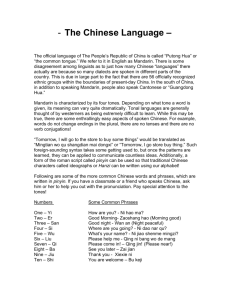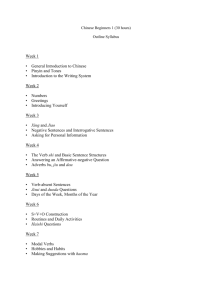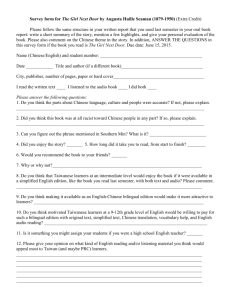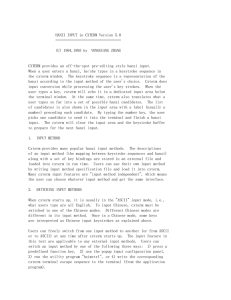Flying with Chinese ACTFL
advertisement
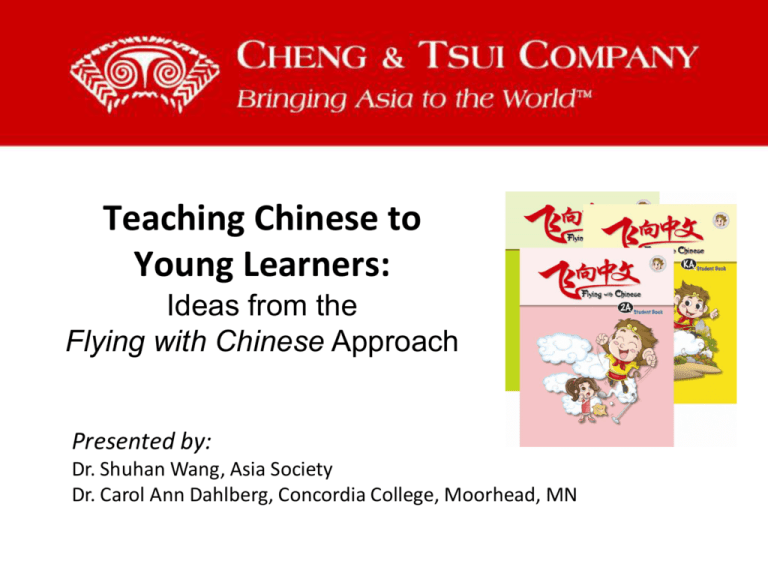
Teaching Chinese to Young Learners: Ideas from the Flying with Chinese Approach Presented by: Dr. Shuhan Wang, Asia Society Dr. Carol Ann Dahlberg, Concordia College, Moorhead, MN Topics in today’s seminar • The Flying with Chinese approach based on current pedagogy • Literacy: balancing oral and written language for young learners *All examples will be taken from Flying with Chinese. Flying with Chinese the series • Ideal for: Grades K-6 • Designed to make the most of children’s natural language-learning ability by creating context • Can be used independently or as part of sequenced study • Each level covers 3 themes suitable for 1 year of study What is the Flying with Chinese Approach? Elements of a good language curriculum: Performancebased Content-related Thematic planning Standards-based Standards-based • Standards for Foreign Language Learning in the 21st C. • ACTFL Performance Guidelines for K-12 Learners Standards provide: • Realistic goals and benchmarks • Balanced curriculum content • Focus on performance and assessment 5C’s – Communication Cultures Connections Comparisons Communities Example of standards e.g. from Grade 1A Teacher Guide Thematic planning Connects content, language, and culture goals to a “big idea” or enduring understanding. Creates a meaningful context. Provides a rich context for standard-based learning. Student-centered: involves students in real language use in a variety of situations, modes, and text types. “Brain-friendly”: takes advantage of the natural ability of the brain to make connections in the process of learning. Links language instruction to the philosophy and content of the general elementary school curriculum. Example of thematic planning • Each of the three volumes for each grade level has a different theme: * Grades 5 and 6 will each combine themes in one volume. Content-Related • Materials in real-life contexts • Connecting with other subjects while teaching Chinese: - environment - social studies - science - language arts - mathematics - visual and performing arts e.g. from Grade 4C Student Book Content presented in story format • Each book / lesson / page / activity is designed as a story e.g. from Grade KA Student Book Performance-based Stages in the Backward Design Process: • Performance Assessments • “I can” statements Identify desired results • Enduring Understandings • Essential Questions Determine acceptable evidence Plan learning experiences and instruction Teacher Guide Examples of performance-based approach Each lesson includes: • Proficiency targets (Teacher Guide) • Assessment (“I can…” statements) e.g. from Grade KA Student Book, Lesson 8 Examples of performance-based approach Each book includes: • Cumulative group activity in the last lesson Children role-play meeting Chinese children during an imaginary trip to China and use learned vocabulary to make friends and exchange information. e.g. from Grade KA Student Book Examples of performance-based approach Each book includes: • A final, summative “I can…” checklist e.g. from Grade 2B Student Book Literacy: connection between oral and written text What connects Oral Language and Literacy Development? “Pre-Literacy” is the Bridge oral text written text written words spoken out loud spoken words written down What is “pre-literacy”? • Uses oral language as the base for literacy. • The act of literacy is important: reading, being read to, looking at prints, icons, etc. Building blocks of Chinese literacy • Hanzi • Key Words and Word Banks • Environmental and Functional Print • Labeling e.g. from Grade KC Student Book; summative hanzi lists appear at the end of every student book. Role of pinyin in teaching young learners •Mastery of hanyu pinyin is critical for students using Chinese word processing on the computer. •“Interference issues” for kindergarten through Grade 2 learners who simultaneously learn phonics, English language arts, and hanyu pinyin. • Less of an issue in later grades, and students can draw on their knowledge of English phonics for help. Hanzi development • In Grades K-2: students are introduced to single hanzi that recur in the lesson, with emphasis on the components of hanzi (strokes); stroke order; the notion of radicals; tracing, copying, and recognition of sound, meaning, and form. ~Pre-Writing vs. Sight Vocabulary Development • In Grade 3 and beyond: students begin to combine individual hanzi into meaningful words, phrases, expressions, and sentences in context for communication. Program Components Students: • Student Books • Workbooks • Student Audio CDs Teachers: • Teacher Guides • Teacher Audio CDs • Flashcards Questions? Contact Shuhan Wang and Carol Ann Dahlberg at: shuhanw@asiasoc.org cadahlbe@cord.edu Continue the conversation with your peers at peerSource http://my.cheng-tsui.com/forum/649 Thank you for attending You will be redirected to a brief survey after this presentation. We appreciate your feedback. Visit www.cheng-tsui.com for more information on Flying with Chinese, and other Chinese language and culture offerings.
